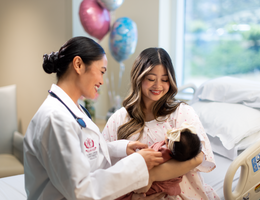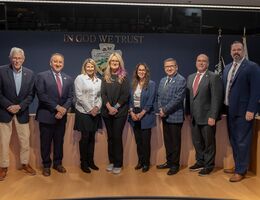
September is Baby Safety Awareness Month, dedicated to helping parents create a safe environment for their little ones. One of the most significant moments in a parent's life is bringing their newborn home from the hospital. Tracy Gould, DO, a pediatrician at Loma Linda University Children's Hospital, has advice to ensure a smooth transition.
Safe sleep
One of the first things to consider is your baby's sleep environment. The American Academy of Pediatrics recommends that newborns sleep in the same room as their parents but in their own crib or bassinet for at least the first six months. The sleep space should have a firm mattress with no blankets, pillows, or stuffed animals. "This helps reduce the risk of Sudden Infant Death Syndrome (SIDS)," Gould said.
Sleep challenges
Newborns don't typically follow a strict sleep schedule. Gould wants to remind parents about the importance of flexibility and suggests swaddling as a technique to help soothe your baby. "Swaddling mimics the cozy environment of the womb and can help your baby feel secure," Gould said.
Water temperature
One often overlooked safety measure is adjusting your home's water heater. Gould recommends setting the temperature to 120 degrees Fahrenheit or lower to prevent accidental burns. "If the water temperature is too high, even a brief exposure could cause scalding," she said. Always test the bathwater with your hand before placing your baby in it.
Gould advises holding off on full baths until the umbilical cord falls off and the area is healed. In the meantime, sponge baths are sufficient.
Create a feeding routine
Gould says parents should be prepared for round-the-clock feeding sessions. Whether you choose breastfeeding or formula, having a plan is essential. "Breastfeeding has many benefits, including the passing of antibodies from mother to baby, which helps protect against infections," she said. However, formula is also a viable option, especially if breastfeeding isn't possible. Newborns typically feed every two to three hours, which amounts to 8-12 feeds in 24 hours.
Spit-up is a common issue, but watch for excessive spit-up or signs of dehydration, such as fewer wet diapers. If you notice these symptoms, consult your pediatrician.
Gould recommends frequent burping during and after feeds and keeping your baby upright during feeding. Bicycle kicks with your baby's legs can also help relieve gas.
Signs of healthy feeding
Gould suggests tracking the number of wet diapers, which should correspond to the number of days old your baby is—one wet diaper on day one, two on day two, and so on, until about day five, when you should expect at least five wet diapers per day. She recommends checking and changing the diaper at each feeding to keep your baby comfortable and to prevent diaper rash.
Postpartum challenges
The postpartum period can be physically and emotionally challenging. "Having friends or family to help with meals or household chores can make a big difference," she suggests. Additionally, parents need to give themselves grace and prioritize rest.
Well-child visits
Regular pediatric visits are essential to monitor your baby's health. At Loma Linda University Children's Hospital, Gould recommends the first visit one to three days after discharge, followed by a two-week checkup, and another at two months. These visits are essential for tracking your baby's growth and development and addressing any concerns.
Vaccinations
Your baby will receive the first hepatitis B vaccine, a Vitamin K injection, and eye ointment soon after birth," she explains. Staying on schedule with vaccinations is essential for your baby's health.
Gould also suggests limiting visitors during the first two months to reduce the risk of infections, which can be severe in newborns.
U.S. News & World Report recognizes Loma Linda University Children’s Hospital as a Best Hospital for Maternity Care. More information about maternity services at LLUCH is available online.


